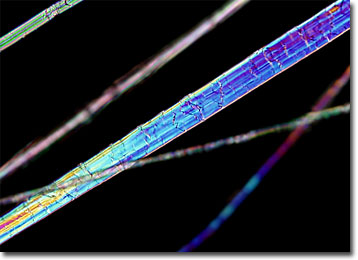Polarized Light Microscopy Digital Image Gallery
Silver Ramie Fibers
Ramie is a bast fiber that is usually derived from the Boehmeria nivea plant native to China. Though cultivated for thousands of years in eastern Asia, ramie fiber and fabrics were not exported to countries in the Western Hemisphere until the 1700s.

View a second, third, and fourth image of a Silver Ramie Fiber
Comprised of cells that are exceptionally long, ramie is one of the strongest vegetable fibers in the world. Because of this, the material is frequently utilized in items that require exceptional strength and durability, such as rope, industrial sewing thread, and fishing nets. Ramie is also very absorbent and a natural lustrous white in color, making it highly accepting of a wide variety of dyes. Yet, the fiber’s poor elasticity makes it more popular in fabric blends than in textiles comprised solely of ramie in many locales. It is, for instance, a common component in cotton knit sweaters, increasing the strength and luster of the apparel’s fabric, which retains most of its flexibility despite the brittleness of ramie.
Sometimes known as China grass or rhea, ramie can be an expensive fiber to produce due to the complex processes involved in extracting and cleaning the material. Cutting, scraping, pounding, washing, heating, chemical exposure, and a number of other steps are often required before the fiber is ready for spinning, which is also difficult due to the brittleness of the fiber. Weaving ramie is a procedure that takes special care as well. Perhaps it is not surprising, therefore, that the world’s leading producer of ramie fibers and fabrics is China, the country that has been carrying out the multifarious stages of ramie production the longest. Korea, the Philippines, and Brazil, however, are China’s strongest competitors in the industry.
